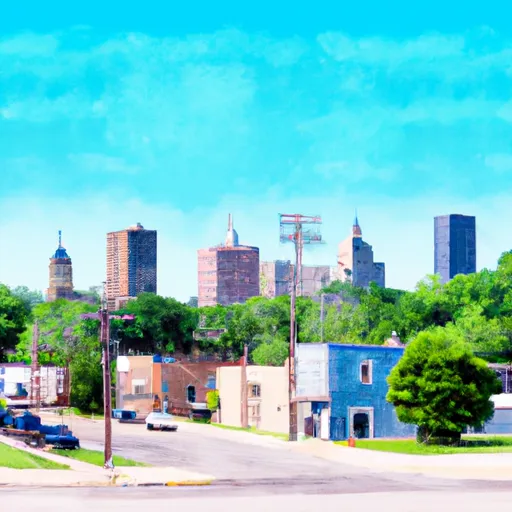-
 Snoflo Premium
Snoflo Premium
Get unlimited access to all our content
With no Ad interruptions! - Start Your Free Trial Login with existing account
Elmwood
Eden Index
Climate
8.0
•
Recreation
2.5
•
Community
3.3
•
Safeguard
4.9/10

Elmwood, Illinois is a small community located in Peoria County. Elmwood experiences a temperate climate with four distinct seasons. Summers are warm with occasional thunderstorms, while winters are cold and snowy. The hydrology constituents of Elmwood include the Spoon River and several small creeks, which offer opportunities for fishing and boating. Outdoor recreation opportunities in Elmwood include hiking, camping, and picnicking at Jubilee College State Park, which boasts over 3,200 acres of rolling hills and woodland. Additionally, the nearby Wildlife Prairie Park offers visitors the chance to see bison, elk, and other native Illinois wildlife.
What is the Eden Index?
The Snoflo Eden Index serves as a comprehensive rating system for regions, evaluating their desirability through a holistic assessment of climate health, outdoor recreation opportunities, and natural disaster risk, acknowledging the profound impact of these factors on livability and well-being.
Climate Health Indicator (CHI): 8.0
Elmwood receives approximately
953mm of rain per year,
with humidity levels near 83%
and air temperatures averaging around
11°C.
Elmwood has a plant hardyness factor of
5, meaning
plants and agriculture in this region thrive during a short period during spring and early summer. Most
plants will die off during the colder winter months.
By considering the ideal temperature range, reliable water supplies, clean air, and stable seasonal rain or snowpacks, the Climate Health Indicator (CHI) underscores the significance of a healthy climate as the foundation for quality living.
A healthy climate is paramount for ensuring a high quality of life and livability in a region, fostering both physical well-being and environmental harmony. This can be characterized by ideal temperatures, reliable access to water supplies, clean air, and consistent seasonal rain or snowpacks.
Weather Forecast
Streamflow Conditions
Lower Illinois
Area Rivers
Lower Illinois
Snowpack Depths
Lower Illinois
Reservoir Storage Capacity
Lower Illinois
Groundwater Levels
Recreational Opportunity Index (ROI): 2.5
The Recreational Opportunity Index (ROI) recognizes the value of outdoor recreational options, such as parks, hiking trails, camping sites, and fishing spots, while acknowledging that climate plays a pivotal role in ensuring the comfort and consistency of these experiences.
Access to outdoor recreational opportunities, encompassing activities such as parks, hiking, camping, and fishing, is crucial for overall well-being, and the climate plays a pivotal role in enabling and enhancing these experiences, ensuring that individuals can engage in nature-based activities comfortably and consistently.
Camping Areas
| Campground | Campsites | Reservations | Toilets | Showers | Elevation |
|---|---|---|---|---|---|
| St. Bernard State Park | None | 3 ft | |||
| DLo Water Park | None | 312 ft | |||
| Lake Mary Crawford | 20 | 293 ft | |||
| New Orleans Reserve Military | None | 0 ft | |||
| Bayou Segnette State Park | None | 0 ft | |||
| Fontainebleau State Park | None | 18 ft | |||
| Simpson County Lake | 11 | 427 ft | |||
| Fairview Riverside State Park | None | 4 ft | |||
| Walkiah Bluff Water Park | None | 38 ft | |||
| Atwood Water Park | None | 218 ft |
Nearby Fishing
Nearby Ski Areas
Catastrophe Safeguard Index (CSI):
The Catastrophe Safeguard Index (CSI) recognizes that natural disaster risk, encompassing floods, fires, hurricanes, and tornadoes, can drastically affect safety and the overall appeal of an area.
The level of natural disaster risk in a region significantly affects safety and the overall livability, with climate change amplifying these risks by potentially increasing the frequency and intensity of events like floods, fires, hurricanes, and tornadoes, thereby posing substantial challenges to community resilience and well-being.
Community Resilience Indicator (CRI): 3.3
The Community Resilience Indicator (CRI) recognizes that education, healthcare, and socioeconomics are crucial to the well-being of a region. The CRI acknowledges the profound impact of these elements on residents' overall quality of life. By evaluating educational resources, healthcare accessibility, and economic inclusivity, the index captures the essential aspects that contribute to a thriving community, fostering resident satisfaction, equity, and social cohesion.

